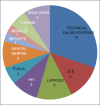Changing trends in acquired syphilis at a Tertiary Care Center of North India
- PMID: 26692606
- PMCID: PMC4660554
- DOI: 10.4103/0253-7184.167151
Changing trends in acquired syphilis at a Tertiary Care Center of North India
Abstract
Introduction: Prevalence and pattern of acquired syphilis are changing in India in recent years because of good laboratory diagnosis and treatment, but it still remains a major public health problem with significant regional variations.
Aim: To study the changing trend of acquired syphilis in a Tertiary Care Center of North India.
Subjects and methods: Retrospective analysis of all the cases of sexually transmitted infections (STIs) registered in the Skin and VD Department of PGIMS, Rohtak from January 2008 to December 2012 was done. Complete epidemiological, clinical, and investigational data were recorded and analyzed for changing trends in prevalence, pattern and clinical presentations of syphilis.
Observation: Total of 1462 cases attended the STI clinic from January 2008 to December 2012. A total of 124 patients were venereal diseases research laboratory reactive, of which 33 (2.25%) were false positive cases, and Treponema pallidum hemagglutination was reactive in 91 cases (6.22%). Totally, 91 (6.22%) cases were diagnosed as syphilis. Of 91 cases, 78 (85.71%) were males and 13 (14.29%) were females. Primary syphilis was diagnosed in 21 (13.08%), secondary in 38 (41.76%), and latent in 32 (35.16%) patients. 4 (10.53%) of the secondary syphilis were having asymptomatic rash, 14 (36.84%) had condyloma lata and 17 (44.74%) had genital ulcer with cutaneous rash. Mixed infection was detected in 7 patients. 8 (8.79%) were human immunodeficiency virus positive.
Conclusion: Although our study indicates a decreasing trend in the prevalence of syphilis in last 5 years, there is a rise in latent syphilis as compared to primary syphilis demanding steps to increase awareness among general population.
Keywords: Acquired syphilis; Treponema pallidum hemagglutination; biological false positive; latent.
Figures
Similar articles
-
Syphilis and COVID-19: Changing trends.Indian J Sex Transm Dis AIDS. 2023 Jul-Dec;44(2):132-134. doi: 10.4103/ijstd.ijstd_22_23. Epub 2023 Dec 6. Indian J Sex Transm Dis AIDS. 2023. PMID: 38223155 Free PMC article.
-
Current status of acquired syphilis: A hospital-based 5-year study.Indian J Sex Transm Dis AIDS. 2012 Jan;33(1):32-4. doi: 10.4103/0253-7184.93814. Indian J Sex Transm Dis AIDS. 2012. PMID: 22529451 Free PMC article.
-
Are we moving from symptomatic to asymptomatic syphilis: A retrospective analysis.Indian J Sex Transm Dis AIDS. 2023 Jan-Jun;44(1):45-48. doi: 10.4103/ijstd.ijstd_109_22. Epub 2023 Jun 6. Indian J Sex Transm Dis AIDS. 2023. PMID: 37457540 Free PMC article.
-
Syphilis: Is it Back with a Bang?Indian Dermatol Online J. 2023 Dec 22;15(1):73-77. doi: 10.4103/idoj.idoj_187_23. eCollection 2024 Jan-Feb. Indian Dermatol Online J. 2023. PMID: 38283002 Free PMC article.
-
Resurgence of syphilis, the great imitator.Med J Armed Forces India. 2022 Apr;78(2):131-135. doi: 10.1016/j.mjafi.2022.03.004. Epub 2022 Mar 23. Med J Armed Forces India. 2022. PMID: 35463552 Free PMC article. Review.
Cited by
-
The Availability of Essential Antimicrobials in Public and Private Sector Facilities: A Cross-Sectional Survey in a District of North India.Antibiotics (Basel). 2024 Jan 29;13(2):131. doi: 10.3390/antibiotics13020131. Antibiotics (Basel). 2024. PMID: 38391517 Free PMC article.
-
Resurgence of sexually transmitted infections in India.Indian J Sex Transm Dis AIDS. 2024 Jul-Dec;45(2):102-109. doi: 10.4103/ijstd.ijstd_120_24. Epub 2024 Dec 13. Indian J Sex Transm Dis AIDS. 2024. PMID: 39886248 Free PMC article. Review.
-
Untreated Late Latent Syphilis of Both Spouses with Observation of Kassowitz Law: Adverse Pregnancy Outcomes in the Postpenicillin Era.Indian J Dermatol. 2017 Mar-Apr;62(2):221-222. doi: 10.4103/0019-5154.201755. Indian J Dermatol. 2017. PMID: 28400651 Free PMC article. No abstract available.
-
Syphilis and COVID-19: Changing trends.Indian J Sex Transm Dis AIDS. 2023 Jul-Dec;44(2):132-134. doi: 10.4103/ijstd.ijstd_22_23. Epub 2023 Dec 6. Indian J Sex Transm Dis AIDS. 2023. PMID: 38223155 Free PMC article.
-
The Changing Trend of Syphilis: Is It a Sign of Impending Epidemic?Indian J Dermatol. 2023 Jan-Feb;68(1):15-24. doi: 10.4103/ijd.ijd_788_22. Indian J Dermatol. 2023. PMID: 37151273 Free PMC article.
References
-
- Morton RS. The treponematoses. In: Rook A, Wilikinson DS, Ebling FJ, Champion RH, editors. Textbook of Dermatology. 4th ed. London: Blackwell; 1986. pp. 839–83.
-
- Thin RN. Early syphilis in the adult. In: Holmes KK, Mardh PA, Sparling PF, Wiesner PJ, editors. Sexually Transmitted Diseases. 2nd ed. New York: McGraw-Hill; 1990. pp. 221–30.
-
- Sanchez M, Luger AF. Syphilis. In: Fitzpatric TB, Eisen AZ, Wolff K, Freedberg IM, Austen FK, editors. Dermatology in General Medicine. 4th ed. New York: McGraw-Hill; 1993. pp. 2703–43.
-
- Garnett GP, Bowden FJ. Epidemiology and control and curable sexually transmitted diseases: Opportunities and problems. Sex Transm Dis. 2000;27:588–99. - PubMed
-
- Kretzschmar M, van Duynhoven YT, Severijnen AJ. Modeling prevention strategies for gonorrhea and Chlamydia using stochastic network simulations. Am J Epidemiol. 1996;144:306–17. - PubMed
LinkOut - more resources
Full Text Sources


